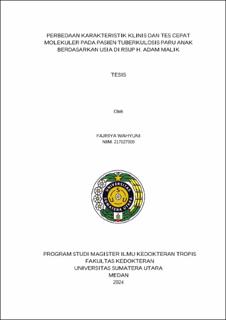| dc.description.abstract | Tuberculosis (TB) remains the most easily transmissible infectious disease with the highest morbidity and mortality rates among other infectious diseases. Rapid case detection is crucial to initiate appropriate treatment and halt the spread of TB infection. Pediatric tuberculosis cases are prevalent in Indonesia., yet there are few reports on pediatric TB. This study aims to examine the clinical characteristics and rapid molecular tests of pediatric pulmonary tuberculosis patients based on age. We conducted a cross-sectional study at Adam Malik Hospital, Medan, Indonesia, from November 2023 to January 2024. Data on clinical characteristics and rapid molecular tests were was retrieved from the electronic medical records of pediatric individuals identified with pulmonary tuberculosis. Chi-square were conducted to evaluate differences in clinical characteristics and rapid molecular tests based on the children's age. This study involved a total of 84 pediatric patients diagnosed with pulmonary tuberculosis, the majority being aged >14-18 years (46.4%) and female (64.3%). The most common clinical characteristics found were cough for ≥ 2 weeks (95.2%). There was a significant difference in the clinical symptom of night sweats among children aged 0-5 years, 5-14 years, and >14-18 years (p = 0.004), while no significant difference was found in other clinical symptoms (p > 0.05). Rapid molecular test yielded positive results in 64.3% of cases, with 14.3% resistant to rifampicin. There was no significant difference in the results of rapid molecular tests among pediatric pulmonary TB patients based on age (p = 0.558) although children aged 0-5 years were more often examined with gastric lavage (21.4%), children aged 5-14 years and >14-18 years were more often examined using sputum specimens (16.7% and 38.1%). We also found cases of primary MDR-TB (66.7%) and primary Pre-XDR-TB (8.3%) among the resistant TB cases in this study. Identification of TB cases and close contact tracing need to be conducted to prevent the further spread of resistant TB. | en_US |


